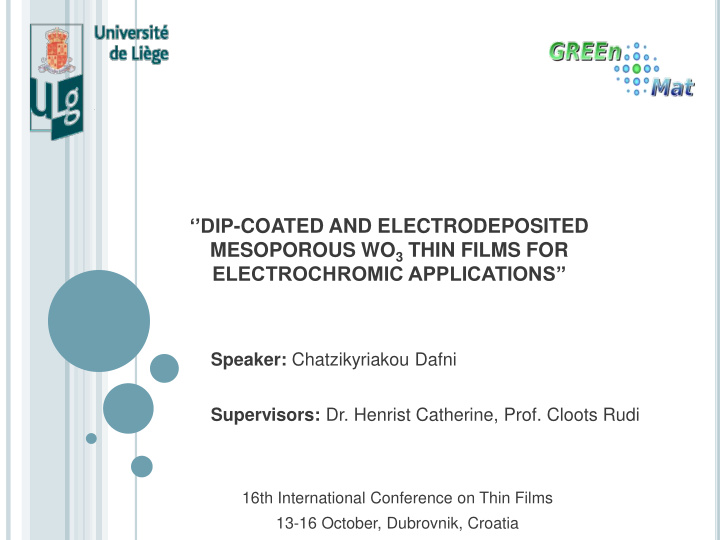



‘’DIP -COATED AND ELECTRODEPOSITED MESOPOROUS WO 3 THIN FILMS FOR ELECTROCHROMIC APPLICATIONS’’ Speaker: Chatzikyriakou Dafni Supervisors: Dr. Henrist Catherine, Prof. Cloots Rudi 16th International Conference on Thin Films 13-16 October, Dubrovnik, Croatia
WO 3 ( PROPERTIES / APPLICATIONS ) n-type semiconductor (2.6-3.25eV) Photocatalyst • Gas sensing applications • Dye-Sensitized Solar Cells (DSSC) • Optical properties/Chromism W(VI) (transparent) W(V) (blue) e - Gasochromism • Electrochromism • e - Thermochromism • e - 2 Photochromism • Li + Li + Li +
WO 3 ( ELECTROCHROMISM / APPLICATIONS ) WO 3 + xLi + + xe - Li x WO 3 Coloured state Bleached state o Electrochromic displays o Auto-dimming car mirrors o Smart windows 3
S MART WINDOWS o Control heat, glare, fading o Reduce the need for air-conditioning o Better management of natural light o Require less than 5V (DC) Reduce energy demands PROBLEM!!! HIGH COST (3x) SMALL MARKET NEED FOR A MORE COST-EFFECTIVE BUT EFFICIENT 4 PRODUCTION ROUTE
GOAL OF THIS WORK COST EFFICIENCY o No vacuum techniques o Cyclic stability o Cheap materials o Reversibility o Optical modulation o Color/Bleach time o Charge density o Coloration efficiency o Increased surface area increase of ‘’active’’ material o Reduces the diffusion length of cations 5
P OROUS FILMS THROUGH TEMPLATING Hydrophilic part metal precursor Hydrophobic part template hydrolysis Removal of condensation the template 6 Acc. Chem. Res. 2007, 40, 784-792 Chem. Soc. Rev., 2013, 42, 4198-4216
T ECHNIQUES 7 Chem. Mater. 2008, 20, 682-737
E XPERIMENTAL PROCEDURE OF THE DIP - COATING TECHNIQUE Controlled RH% Controlled speed Evaporation Induced W x (H 2 O 2 ) y (acetic acid) z in Self-Assembly (EISA) EtOH/H 2 O Brij-56 in EtOH/H 2 O Calcination at elevated temperatures Crystalline films o Robust and rigid materials o Less absorption of visible light Porous amorphous films 8 Superior electrochromic properties D. Chatzikyriakou et al., Electrochimica Acta 137 (2014), 75-82
S TRUCTURAL CHARACTERIZATION OF THE DIP - COATED FILMS Without template With template dense film porous film o Regular porosity Compact and smooth o Pores diameter: 2-3nm surface 9 o Pore-pore distance: 6nm o Wall thickness: 3-4nm
E LECTROCHROMIC CHARACTERIZATION OF THE DIP - COATED FILMS : C YCLIC VOLTAMMETRY oxidation I (A.cm -2 ) I (A.cm -2 ) E (V) vs. Li/Li + E (V) vs. Li/Li + reduction porous film dense film Reversibility % 1 st cycle 20 th cycle 10 Permanent coloration Dense film 54% 94% Porous film 93% 98%
E LECTROCHROMIC CHARACTERIZATION FOR THE DIP - COATED FILMS : C HRONOAMPEROMETRIC MEASUREMENTS 0,6 Time for attaining the 10% dense film of total current capacity mesoporous film (20 th cycle) Sample 0,4 Coloration Bleaching 4.225V vs. Li/Li + time (s) time (s) I (mA.cm -2 ) 0,2 bleaching Dense film 48 11 0,0 Porous film 100 32 2.225V vs. Li/Li + -0,2 coloration -0,4 Dense film faster inter-/de-intercalation 0 100 200 300 400 time (s) Charge capacity (mC.cm -2 ) Charge capacity (mC.cm -2 ) De- Intercalation De- Sample intercalation Intercalation (20 th cycle) intercalation (20 th cycle) (20 th cycle) 11 (20 th cycle) Dense film 3.3 3.1 3.3 3.1 Porous film 8.0 7.8 18.0 17.4
E LECTROCHROMIC CHARACTERIZATION OF THE DIP - COATED FILMS 90 90 Virgin state Virgin state 80 80 Bleached state 70 70 60 Bleached state 60 T% T (%) 50 50 Coloured state 40 40 Coloured state 30 virgin film colored film 30 virgin film bleached film porous film dense film 20 colored film bleached film 20 10 400 500 600 700 800 900 1000 400 500 600 700 800 900 1000 wavelength (nm) wavelength (nm) Optical Δ T% (550/750nm) Efficiency (cm -2 /C) Sample 20 th cycle (550/750nm) log (Tb/Tc) η = C 12 Dense film 4.6/5.6 12/17 Porous film 27.2/40.4 33/60
S UMMARIZING FOR THE DIP - COATED FILMS Mesoporous film Dense film Switching kinetics Worse Better Charge capacity Better Worse (mC.cm -2 ) Reversibility Better Worse ΔΤ% Better Worse Coloration Better Worse efficiency 13 Porous film has better properties than the dense film
E XPERIMENTAL PROCEDURE FOR THE ELECTRODEPOSITION o Reduction of H 2 O 2 (W(H 2 O 2 ) x (CH 3 COO) y ) to OH - o Precipitation of MO x (OH) y on the surface of the electrode o Framework’s built-up around the template o Calcination (350 o C/2h or 400 o C/1h) PSS-Na Reference electrode (Calomel) Counter electrode (Pt) Working electrode 14 (glass/FTO) 350mC.cm -2
S TRUCTURAL CHARACTERIZATION OF THE ELECTRODEPOSITED FILMS CALCINED AT 350 O C -0.5V -0.6V dense dense Uncalcined films -0.4V porous -0.4V Less PSS-Na Not homogeneous coating!! 15 Balance between condensation and co-assembly formation
S TRUCTURAL CHARACTERIZATION OF THE ELECTRODEPOSITED FILMS 400 o C/1h 400 o C/1h CRYSTALLINE FILMS 16
S TRUCTURAL CHARACTERIZATION OF THE ELECTRODEPOSITED FILMS -0.6V -0.5V dense films -0.4V -0.4V porous Less PSS-Na Porous films Not adequate coating!! 17
E LECTROCHROMIC CHARACTERIZATION OF THE ELECTRODEPOSITED FILMS : C YCLIC VOLTAMMETRY Partial deterioration Porous film Dense film Reversibility % Dense Porous 1 st cycle 20 th cycle Dense film 83% (54%) 18 Porous film 91% (77%)
E LECTROCHROMIC CHARACTERIZATION FOR THE ELECTRODEPOSITED FILMS : C HRONOAMPEROMETRIC MEASUREMENTS Time for attaining the 10% of total current capacity (20 th cycle) Sample Coloration Bleaching time time (s) (s) Dense film 26 10 Porous film 20 9 Charge capacity (mC.cm -2 ) Intercalation De-intercalation Sample (20 th cycle) (20 th cycle) Dense film 1.8 1.5 Porous film 3.8 3.5 19 Thickness and relative amount of W have not been adjusted yet
S UMMARIZING FOR THE ELECTRODEPOSITED FILMS Porous films at -0.4V but not at -0.5V/-0.6V Calcination at 400 o C gives porous but crystalline films Deterioration of the porous film upon cycling (porous are still filled with polymer) Film at -0.5V (dense film) similar behavior with the dense film of the dip-coating technique Higher charge capacity for the films at -0.4V (porous films) Thank you for your attention! 20
Recommend
More recommend